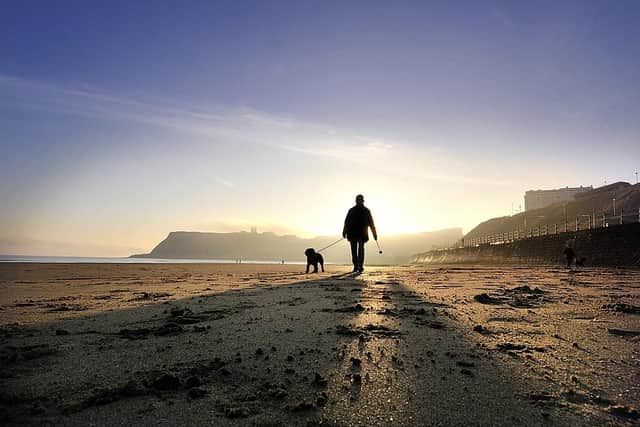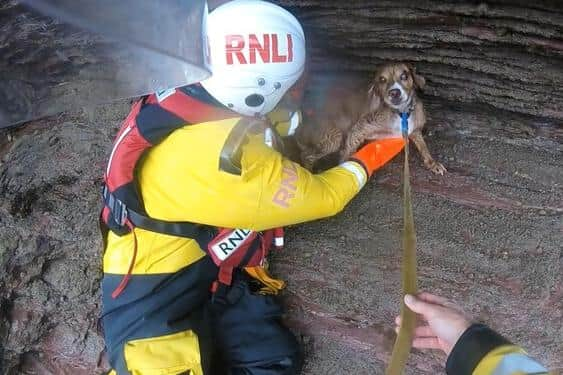How to keep your dogs safe while on the beach along the Yorkshire Coast this summer according to RNLI and Dogs Trust
While the weather is not great right now, Yorkshire Coast beaches continue to be very popular with those who enjoy a long walk and those with pet dogs.
Two charities RNLI and Dogs Trust have collaborated to ensure our canine friends and their owners stay safe along the coast this summer.
Advertisement
Hide AdAdvertisement
Hide AdIt is believed that a third of all UK households now own a dog, and last year the RNLI rescued 164 of these dogs around the UK’s coastlines. Rescue missions this year include plucking dogs from the waves, rescuing stricken puppies trapped on coastal ledges and dogs cut off by the tide.


To help reduce the number of these incidents, the charities have published some guidance to help dogs and their owners enjoy the seaside without the fear of danger or risk.
Before you go to the beach or on a coastal walk, it is crucial that you always check the weather and tide times, and avoid taking your dog out in high temperatures.
Dogs cannot regulate their body heat in the same way as humans can, so extra care needs to be taken in hot weather. If dogs are too hot and cannot reduce their body heat enough, they may develop heatstroke which can be fatal.
Advertisement
Hide AdAdvertisement
Hide AdIf you are happy that the weather is suitable for your dog, there are other important things to consider to help you enjoy a stress-free trip to the seaside with your furry friend.


Hannah Duerden, from the Dogs Trust education team, said: “Many dogs love to visit the beach, with the sea and the sand providing lots of enrichment and fun for them.
“However, as RNLI stats show, dogs can get into trouble on trips to the coast, so it’s important to take some basic steps to keep them safe, including keeping them on their leads near cliff tops, ensuring they have access to shade and fresh water and making sure the sand is not too hot for them to walk on.
“But keeping our dogs safe at the coast starts before you even leave home. Always check the weather forecast, and if it’s too warm, stay at home. Heat stroke makes dogs very poorly, and in some cases can prove fatal.”
Advertisement
Hide AdAdvertisement
Hide AdLewis Arnold, Lifeboat Coxswain at RNLI Newhaven Lifeboat Station, said: “As a dog owner, I know how much people’s pets mean to them, so I understand what’s at stake when we are being called out to rescue a dog.
“We will always launch the lifeboat if there is an animal in trouble on the coast, but there are a few things you can do to make sure it’s not yours that we are going to save.
“Keep your dog on a lead when near cliff edges, harbour sides, or fast-flowing water, and if they do fall or enter the water unexpectedly don’t go in yourself. If you move to somewhere safe and call them, they will probably get out by themselves.
“If you are worried about your dog, call 999 and ask for the coastguard – don’t go after them and put yourself in danger.”
Top tips to keep dogs safe on beaches along the Yorkshire Coast
Below are some tips put together by RNLI and Dogs Trust.
1 - Check you are going to a dog-friendly beach
Advertisement
Hide AdAdvertisement
Hide AdSome beaches prohibit dogs from entering at certain times of the year, and others have dog-free areas. But not to worry, there are plenty of dog-friendly beaches all around the UK, including Yorkshire.
2 - Make sure you keep your dog on a lead if you are close to cliff edges or fast-flowing water
If you are on the beach and your dog has not learnt the art of recall, make sure you keep them on a lead. Long training leads will give your dog the freedom to explore while helping to keep them safe.
3 - Always check the tide times
Before you head over to the beach for a walk with your dog, always check the tide times and plan your trip accordingly to make sure you don’t get stranded. Tide times and heights fluctuate throughout the month, so an area that was accessible throughout the day last week may get completely cut off today.
4 - Make sure the sand isn’t too hot
Advertisement
Hide AdAdvertisement
Hide AdDogs love spending time in the sand, digging and exploring. But before you take your dog on the beach, check that the sand isn’t too hot to touch. If you can stand on it comfortably barefoot then it should be ok for them too.
5 - Provide shade and fresh drinking water for your dog
Provide the water and shade all day and pack some tasty treats so that you can swap any unsuitable items your puppy picks up on the beach for a dog-friendly snack.
6 - Don’t let them get burned
Keep your dog out of direct sunlight where you can. Use pet-safe sun cream on exposed parts of your dog’s skin, like the tips of their ears and nose. Ask your vet for more advice if necessary.
7 - Dogs shouldn’t drink sea water as it can cause sickness and saltwater poisoning
Advertisement
Hide AdAdvertisement
Hide AdKeep a close eye on your dog to make sure they are not eating or drinking anything they shouldn’t such as seaweed, plastic or sea water. Call the local vet if they do.
8 - Rinse any sand and sea water off your dog’s coat and paws
You can rinse your dog with tap water to stop it from accumulating and causing irritation.
9 - If your dog gets into trouble don’t go after it
If your dog goes into the water, over a cliff edge or gets stuck in mud, don’t go after them. Move to a place your dog can reach safely and call them. If you are worried about your dog, call 999 or 112 and ask for the Coastguard. The RNLI treats stricken pets the same as it does humans, and will always launch to assist if they can.
10 - Dogs should never be left alone in cars
Advertisement
Hide AdAdvertisement
Hide AdEven for just a few minutes in a hot car can prove fatal. On a 22C day, the temperature inside a car could rise by eleven degrees in just 10 minutes and as dogs can’t cool down the same way as humans, the heat can quickly become dangerous. If you see a dog in distress, call 999.
Comment Guidelines
National World encourages reader discussion on our stories. User feedback, insights and back-and-forth exchanges add a rich layer of context to reporting. Please review our Community Guidelines before commenting.
